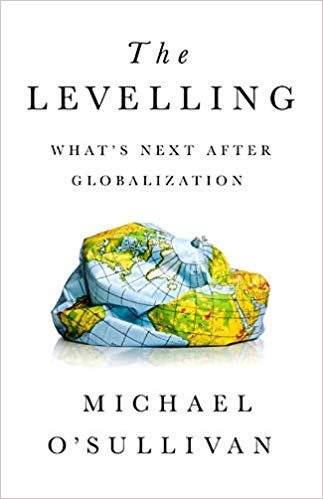You have /5 articles left.
Sign up for a free account or log in.
 The Levelling: What's Next After Globalization by Michael O’Sullivan
The Levelling: What's Next After Globalization by Michael O’Sullivan
Published in May of 2019
The thesis of The Levelling is that we are at the end of the age of globalization. The book argues that our integrated world of institutions, brands, and trade is being replaced by something that is less interconnected.
The end of globalization is not an idea that I had previously given much thought to before reading The Levelling. Sure, the signs are all around. Brexit, Trump, and Trump's trade wars are all rejections of a globalized order.
If O'Sullivan is right, and the reversals of international connectivity are part of a long-term shift as opposed to a short-term blip, then what might be the implications for higher ed?
Today, over 1 million international students enroll in US colleges and universities. The percentage of all international students that choose to attend school in the US has dropped since 2016, but the US still leads the world in educating global learners.
The largest sending countries for university students are China (351,000), India (186,000), South Korea (59,000), and Saudi Arabia (53,000). The largest 3 majors for International students are engineering (21%), business (19%), and computer science / math (15%). Undergraduate students (450,000) slightly outnumber graduate students (400,000).
Higher education is among America's most important export sectors. International students support directly or indirectly over 450,000 jobs. The provision of education and credentialing to international students generates over $42 billion each year. Our higher education trade surplus is over $34 billion.
Recently, however, the international student higher ed news has not been good. The number of international students fell 3.3 percent in 2016 and then dropped a further 6.9 percent in 2017.
We don't know if the Trump administration's diplomatic and immigration policies will further drive down the flows of international students. China is also investing massively in building out the scale and quality of its postsecondary system.
The good news for higher education, perhaps, is that I remain unconvinced by the central reverse-globalization thesis of The Levelling. O'Sullivan writes that academics are blind to the realities of the new localism. So this may be a blindspot.
I found the arguments of The Levelling unconvincing because I had trouble following the book's logic. O'Sullivan has created a mix of trend analysis with anecdotal observation. Rather than developing a hypothesis to be tested with the data, he uses every story as confirmation of his conclusions.
On a basic level, I was never able to connect precisely how a failed 17th-century political movement (the Levellers) fits with today's retrograde politics of immigrant-bashing. O'Sullivan's concern with levels of inequality, indebtedness, and climate change is admirable - but I was unconvinced by his culprits of central bankers. A better book on intangible infrastructure - O'Sullivan's term for the health and human capital and well-being of a population - lurks within The Levelling.
For those wishing to understand the future of higher education through a globalization lens, The Levelling will be a frustrating read.
I think that the story of global demand for US higher education is yet to be written. I'd argue that we have opportunities to expand the number of international students, but only if we accelerate investments in alternative and lower-cost educational models. If I'm right, in 20 years our schools will be more global in outlook and practices. And that we will educate an even higher proportion of international students relative to native-born.
This view of the globalization of American higher education runs directly counter to the arguments of The Levelling. What the book does do is remind us that succeeding on the global stage is not a foregone conclusion. Our colleges and universities will need to prioritize the education of international students. This global strategy will require that we do some things differently than we are doing now.
What community of practice is engaged in discussions at the intersection of higher education change and globalization?
What are you reading?








